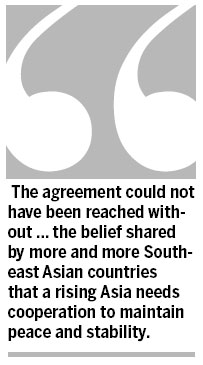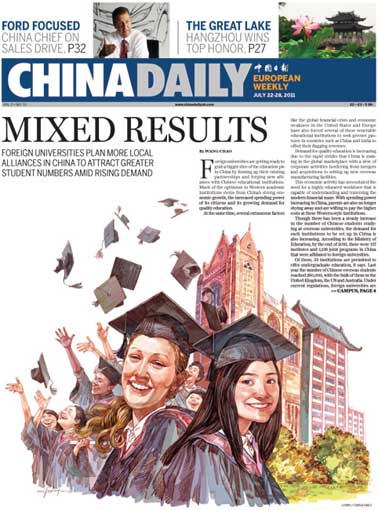Op-Ed Contributors
Window on regional future
Updated: 2011-07-27 07:37
By Chu Hao (China Daily)

ASEAN and China share many common interests and the consensus is to resolve differences through dialogue
A series of Foreign Ministers' Meetings of the Association of Southeast Asian Nations (ASEAN) Regional Forum held in Bali, Indonesia, from July 16 to 23, discussed the future development of the ASEAN Regional Forum (ARF) mechanism, regional cooperation framework and relevant regional and international issues.
In view of the remarks by US Secretary of State Hillary Clinton at last year's ASEAN summit, held in Hanoi, that the South China Sea is in the "national interests" of the United States, international media outlets had predicted that the meetings would be a "war of words", China would be besieged and the meeting would further sour Sino-US ties. The forum was seen as a window to observe the status of Sino-US relations and the future geopolitical landscape of eastern Asia.
With the efforts of China and most ASEAN member states, China and ASEAN adopted an agreement on the guidelines of implementing the Declaration on the Conduct of Parties in the South China Sea (DOC), despite the attempts by some countries to deviate from the aim and endeavors of the ARF and hype bilateral disputes at the regional multilateral forum.
The agreement could not have been reached without China's diplomatic efforts, and the belief shared by more and more Southeast Asian countries that a rising Asia needs cooperation to maintain peace and stability.
The ARF is a platform for relevant countries to enhance mutual trust and strengthen cooperation. So to ensure the discussions were consistent with its purpose and to prevent irrelevant issues from dominating or kidnapping the agenda were in the interests of all parties. China has shown the greatest goodwill and sincerity in promoting regional mutual trust and cooperation and pushing forward healthy development of the forum.
The success of the meetings reflected three facts.
First, for ASEAN, China is a partner rather than a threat. To maintain regional peace and stability, promote economic development and improve people's livelihoods is the common responsibility of the 27 ARF member states.
Over the past three decades, China has made major contributions to the region's peace, stability and development. China will firmly stick to the path of peaceful development and its win-win strategy of opening-up. It will adhere to the policy of good-neighborliness and work with all Asia-Pacific nations to build a harmonious regional environment of lasting peace and common prosperity.
Second, to carefully cultivate and actively promote Sino-US relations is in the interests of both sides, and the expectations of the international community. Benign Sino-US strategic competition is on track. In January, Chinese President Hu Jintao conducted a successful state visit to the US and reached a broad-based consensus with his US counterpart Barack Obama, mapping out the major directions for bilateral ties.
During the ARF, Hillary Clinton said she commended China and ASEAN for working closely together and said the US understands the complexities of the South China Sea disputes and takes no position on the issue. This indicates that Beijing and Washington can avoid misunderstandings in the region.
Finally, China and ASEAN have more common interests than differences. Cooperation between China and ASEAN countries is on a healthy development track. This year marks the 20th anniversary of the establishment of the dialogue mechanism between China and ASEAN. In the first five months of this year, the bilateral trade value rose 26 percent to $140.8 billion. Last year, China became the largest trade partner of ASEAN and in April, ASEAN replaced Japan as the third largest trade partner of China.
Under the principles of cooperation and common development, the South China Sea disputes should be settled peacefully through friendly negotiations by the parties concerned.
Over the past decades, the Asia-Pacific region in general has maintained peace, stability and quick and sustained economic growth, and has become an important engine for global economic growth. Regional cooperation has made vigorous progress. Cooperation mechanisms, including ASEAN, 10+1, 10+3, East Asia Summit, ARF and APEC have made steady improvements and developed side by side.
Though there still exist some destabilizing factors in the region, including territorial disputes that are a legacy of the past, traditional and non-traditional security threats, to resolve differences through dialogue and negotiation and meet common challenges through cooperation is the consensus of the countries in this region. The hard-earned peace and stability of the region is the outcome of sincere efforts by all the relevant parties. The beneficiaries of this peace and stability, wherever they are, should treasure it.
The author is a research assistant of the Institute of South and Southeast Asia and Oceania Studies, China Institutes of Contemporary International Relations.
(China Daily 07/27/2011 page8)
E-paper

Ringing success
Domestic firms make hay as shopping spree by middle class consumers keeps cash registers ringing in Nanjing
Mixed Results
Crowning achievement
Living happily ever after
Specials

Ciao, Yao
Yao Ming announced his retirement from basketball, staging an emotional end to a glorious career.

Going the distance
British fitness coach comes to terms with tragedy through life changes

Turning up the heat
Traditional Chinese medicine using moxa, or mugwort herb, is once again becoming fashionable
